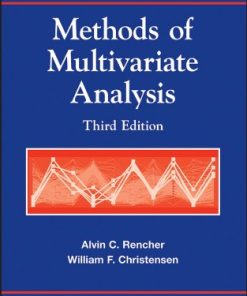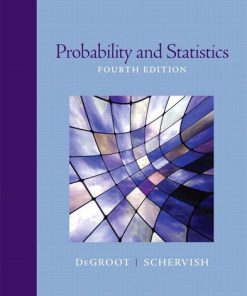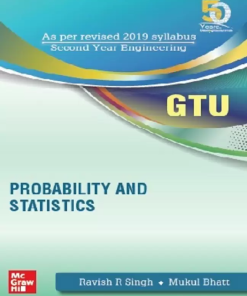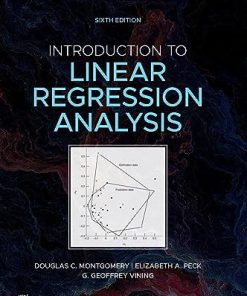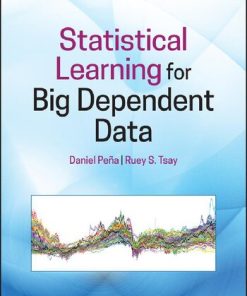Tille Sampling and Estimation from Finite Populations Wiley Series in Probability and Statistics 1st edition by Yves Tille 1119071273 9781119071273
$50.00 Original price was: $50.00.$25.00Current price is: $25.00.
Tille, Y: Sampling and Estimation from Finite Populations (Wiley Series in Probability and Statistics) 1st edition by Yves Tille – Ebook PDF Instant Download/DeliveryISBN: 1119071273, 9781119071273
Full download Tille, Y: Sampling and Estimation from Finite Populations (Wiley Series in Probability and Statistics) 1st edition after payment.
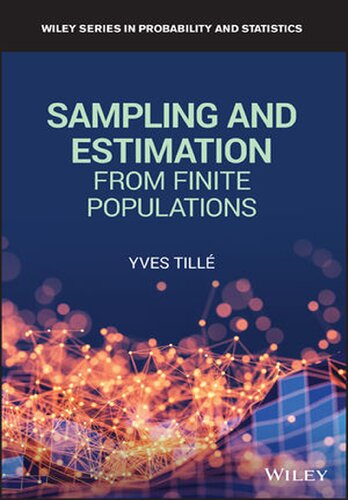
Product details:
ISBN-10 : 1119071273
ISBN-13 : 9781119071273
Author: Yves Tille
A much-needed reference on survey sampling and its applications that presents the latest advances in the field Seeking to show that sampling theory is a living discipline with a very broad scope, this book examines the modern development of the theory of survey sampling and the foundations of survey sampling. It offers readers a critical approach to the subject and discusses putting theory into practice. It also explores the treatment of non-sampling errors featuring a range of topics from the problems of coverage to the treatment of non-response. In addition, the book includes real examples, applications, and a large set of exercises with solutions. Sampling and Estimation from Finite Populations begins with a look at the history of survey sampling. It then offers chapters on: population, sample, and estimation; simple and systematic designs; stratification; sampling with unequal probabilities; balanced sampling; cluster and two-stage sampling; and other topics on sampling, such as spatial sampling, coordination in repeated surveys, and multiple survey frames. The book also includes sections on: post-stratification and calibration on marginal totals; calibration estimation; estimation of complex parameters; variance estimation by linearization; and much more. Provides an up-to-date review of the theory of sampling Discusses the foundation of inference in survey sampling, in particular, the model-based and design-based frameworks Reviews the problems of application of the theory into practice Also deals with the treatment of non sampling errors Sampling and Estimation from Finite Populations is an excellent book for methodologists and researchers in survey agencies and advanced undergraduate and graduate students in social science, statistics, and survey courses.
Tille, Y: Sampling and Estimation from Finite Populations (Wiley Series in Probability and Statistics) 1st Table of contents:
Chapter 1: A History of Ideas in Survey Sampling Theory
1.1 Introduction
1.2 Enumerative Statistics During the 19th Century
1.3 Controversy on the use of Partial Data
1.4 Development of a Survey Sampling Theory
1.5 The US Elections of 1936
1.6 The Statistical Theory of Survey Sampling
1.7 Modeling the Population
1.8 Attempt to a Synthesis
1.9 Auxiliary Information
1.10 Recent References and Development
Notes
Chapter 2: Population, Sample, and Estimation
2.1 Population
2.2 Sample
2.3 Inclusion Probabilities
2.4 Parameter Estimation
2.5 Estimation of a Total
2.6 Estimation of a Mean
2.7 Variance of the Total Estimator
2.8 Sampling with Replacement
Chapter 3: Simple and Systematic Designs
3.1 Simple Random Sampling without Replacement with Fixed Sample Size
3.2 Bernoulli Sampling
3.3 Simple Random Sampling with Replacement
3.4 Comparison of the Designs with and Without Replacement
3.5 Sampling with Replacement and Retaining Distinct Units
3.6 Inverse Sampling with Replacement
3.7 Estimation of Other Functions of Interest
3.8 Determination of the Sample Size
3.9 Implementation of Simple Random Sampling Designs
3.10 Systematic Sampling with Equal Probabilities
3.11 Entropy for Simple and Systematic Designs
Chapter 4: Stratification
4.1 Population and Strata
4.2 Sample, Inclusion Probabilities, and Estimation
4.3 Simple Stratified Designs
4.4 Stratified Design with Proportional Allocation
4.5 Optimal Stratified Design for the Total
4.6 Notes About Optimality in Stratification
4.7 Power Allocation
4.8 Optimality and Cost
4.9 Smallest Sample Size
4.10 Construction of the Strata
4.11 Stratification Under Many Objectives
Chapter 5: Sampling with Unequal Probabilities
5.1 Auxiliary Variables and Inclusion Probabilities
5.2 Calculation of the Inclusion Probabilities
5.3 General Remarks
5.4 Sampling with Replacement with Unequal Inclusion Probabilities
5.5 Nonvalidity of the Generalization of the Successive Drawing without Replacement
5.6 Systematic Sampling with Unequal Probabilities
5.7 Deville’s Systematic Sampling
5.8 Poisson Sampling
5.9 Maximum Entropy Design
5.10 Rao–Sampford Rejective Procedure
5.11 Order Sampling
5.12 Splitting Method
5.13 Choice of Method
5.14 Variance Approximation
5.15 Variance Estimation
Exercises
Chapter 6: Balanced Sampling
6.1 Introduction
6.2 Balanced Sampling: Definition
6.3 Balanced Sampling and Linear Programming
6.4 Balanced Sampling by Systematic Sampling
6.5 Methode of Deville, Grosbras, and Roth
6.6 Cube Method
6.7 Variance Approximation
6.8 Variance Estimation
6.9 Special Cases of Balanced Sampling
6.10 Practical Aspects of Balanced Sampling
Exercise
Chapter 7: Cluster and Two‐stage Sampling
7.1 Cluster Sampling
7.2 Two‐stage Sampling
7.3 Multi‐stage Designs
7.4 Selecting Primary Units with Replacement
7.5 Two‐phase Designs
7.6 Intersection of Two Independent Samples
Exercises
Chapter 8: Other Topics on Sampling
8.1 Spatial Sampling
8.2 Coordination in Repeated Surveys
8.3 Multiple Survey Frames
8.4 Indirect Sampling
8.5 Capture–Recapture
Chapter 9: Estimation with a Quantitative Auxiliary Variable
9.1 The Problem
9.2 Ratio Estimator
9.3 The Difference Estimator
9.4 Estimation by Regression
9.5 The Optimal Regression Estimator
9.6 Discussion of the Three Estimation Methods
Chapter 10: Post‐Stratification and Calibration on Marginal Totals
10.1 Introduction
10.2 Post‐Stratification
10.3 The Post‐Stratified Estimator in Simple Designs
10.4 Estimation by Calibration on Marginal Totals
10.5 Example
Chapter 11: Multiple Regression Estimation
11.1 Introduction
11.2 Multiple Regression Estimator
11.3 Alternative Forms of the Estimator
11.4 Calibration of the Multiple Regression Estimator
11.5 Variance of the Multiple Regression Estimator
11.6 Choice of Weights
11.7 Special Cases
11.8 Extension to Regression Estimation
Chapter 12: Calibration Estimation
12.1 Calibrated Methods
12.2 Distances and Calibration Functions
12.3 Solving Calibration Equations
12.4 Calibrating on Households and Individuals
12.5 Generalized Calibration
12.6 Calibration in Practice
12.7 An Example
Chapter 13: Model‐Based approach
13.1 Model Approach
13.2 The Model
13.3 Homoscedastic Constant Model
13.4 Heteroscedastic Model 1 Without Intercept
13.5 Heteroscedastic Model 2 Without Intercept
13.6 Univariate Homoscedastic Linear Model
13.7 Stratified Population
13.8 Simplified Versions of the Optimal Estimator
13.9 Completed Heteroscedasticity Model
13.10 Discussion
13.11 An Approach that is Both Model‐ and Design‐based
Chapter 14: Estimation of Complex Parameters
14.1 Estimation of a Function of Totals
14.2 Variance Estimation
14.3 Covariance Estimation
14.4 Implicit Function Estimation
14.5 Cumulative Distribution Function and Quantiles
14.6 Cumulative Income, Lorenz Curve, and Quintile Share Ratio
14.7 Gini Index
14.8 An Example
Chapter 15: Variance Estimation by Linearization
15.1 Introduction
15.2 Orders of Magnitude in Probability
15.3 Asymptotic Hypotheses
15.4 Linearization of Functions of Interest
15.5 Linearization by Steps
15.6 Linearization of an Implicit Function of Interest
15.7 Influence Function Approach
15.8 Binder’s Cookbook Approach
15.9 Demnati and Rao Approach
15.10 Linearization by the Sample Indicator Variables
15.11 Discussion on Variance Estimation
Chapter 16: Treatment of Nonresponse
16.1 Sources of Error
16.2 Coverage Errors
16.3 Different Types of Nonresponse
16.4 Nonresponse Modeling
16.5 Treating Nonresponse by Reweighting
16.6 Imputation
16.7 Variance Estimation with Nonresponse
Chapter 17: Summary Solutions to the Exercises
People also search for Tille, Y: Sampling and Estimation from Finite Populations (Wiley Series in Probability and Statistics) 1st:
a sampler on sampling
a sampling
sampling techniques. john wiley & sons
sampling and estimation techniques
sampling techniques. 3rd edition john wiley & sons new york
Tags: Sampling, Estimation, Finite Populations, Wiley Series, Probability, Statistics, Yves Tille
You may also like…
Uncategorized
Mathematics
Mathematics - Mathematical Statistics
Mathematics - Probability
Introduction to Linear Regression Analysis (Wiley Series in Probability and Statistics) 6th Edition
Uncategorized
Medicine - Clinical Medicine
Bailey & Scott’s Diagnostic Microbiology 15th Edition Patricia Tille




